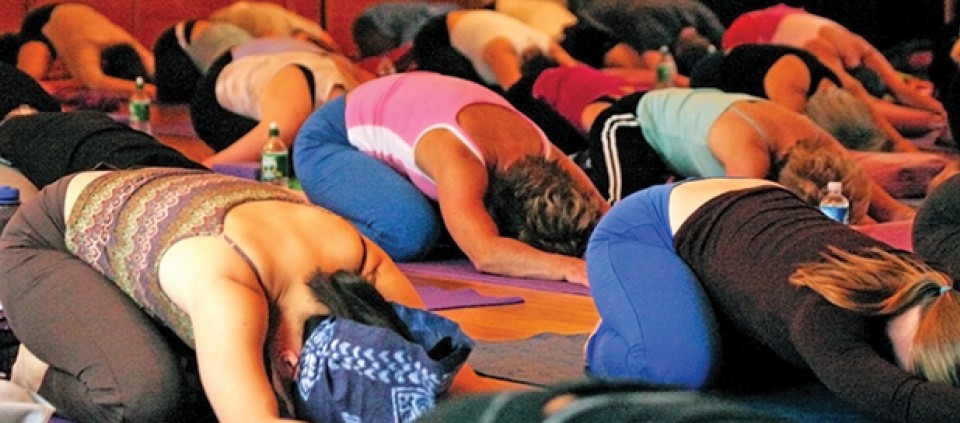Yoga as a Language of Peace

by Jennifer Lang
The group of teenagers is sprawled out around me on the grass. They’re laughing and smiling, happy to be at the park in early June on a Friday morning, their day off from school, on one of their group’s last get-togethers.
“Okay, turn to someone near you who is not from your city and sit back to back in Sukhasana,” I say, crossing my legs to show them Easy pose. “Boys partner with boys, and girls with girls.” I don’t have a partner, but they imitate my movement.
“Now lean into each other and close your eyes.” I speak loudly and slowly, enunciating every word, since English is not everyone’s native tongue. “Put your hands together in front of your heart and just breathe.” Some kids giggle. Some are quiet, serious, concentrating hard in order to comprehend. “Try to feel your partner’s breath.”
This group is made up of about two dozen high school students, half of them Arab Israelis and the other half Jewish Israelis of American, Canadian, and British origin—including my 14-year-old daughter. The pilot program that brings them to this park today was designed by two women, an American Jew living in the city of Raanana, and an Arab Muslim from nearby Tira, a predominately Sunni Muslim city at the eastern edge of Israel. Their vision: 10 Friday mornings together to break down barriers, learn about each other’s culture, and bond. During the past weeks, they’ve created and shared PowerPoint presentations about their families, painted a mural outside a school with the guidance of a visiting artist, and written and performed their own songs, among other activities. Today is sports day, with yoga included.
In 1990, during my first stint in Israel, I edited papers on Arab-Jewish co-existence for a sociology professor at the University of Haifa. Those were the years that Yitzhak Rabin was in power, and peace talks dominated world news. I enrolled in an Arabic conversation class, convinced that Jews should learn to speak Arabic and Arabs should learn to speak Hebrew, and that only once everyone spoke each other’s language could there be meaningful dialogue.
Twenty-three years have passed, during which I have left and returned to this land. My daughter has not yet mastered Hebrew, and Arabic isn’t taught in her school. But I couldn’t care less, because this program offers a way for kids to connect in another language, a new way.
I instruct the kids to get on their hands and knees for Cat and Cow. With an arched spine, we look up at the sky and, with a rounded one, down at our bellies. From there, I have them tuck their toes and lift up into Downward-Facing Dog.
“Halas,” one of the Arab boys says. It’s common Arabic slang, meaning something like “Enough already!,” that has migrated into the Jewish kids’ vocabulary. His outburst makes everyone laugh. I smile, too.
“Breathe as you bend one knee and straighten the other. Pedal your feet—lefadel reglayim,” I add in Hebrew to help the teens for whom Hebrew is their second language and English their third.
I move them from Down Dog to Plank five times. The boys grunt and groan, and the girls collapse in hysterics. After Tree, Warrior I and II, Triangle, and Crow, I ask them to turn to their partner.
“The next pose is Friendship Bridge.” This choice is my hidden agenda since, without each other’s support, they’ll fall. “Face each other and extend your forearms.” I choose the closest girl to demonstrate with me. “Lock arms, look each other in the eyes, stand with your legs and feet parallel, and begin to back slowly away from one another. Lean back away from your partner.” I thank my demo girl and walk around to assist. Some kids sit out, maybe overheated or tired or just uncomfortable.
After holding both of each other’s arms, they hold one arm at a time. Then, since our hour is closing in on us, I have them sit for Upavistha Konasana (Wide Angle Seated Forward Bend), holding hands, moving their bodies back and forth. Then they sit back to back in pairs again, and link elbows while I instruct one person to fold forward and the other to lean back, and then switch. They end sitting cross-legged, hands at their hearts in prayer, once again breathing into one another’s backs. Before we close our eyes, I take one more long look at this group of brave, open-minded, openhearted young people.
This is it, I think. This is the common language, a means of expression to help overcome prejudices, close gaps, and open lines of communication. Two decades ago, I dreamed of everyone speaking each other’s language, and now, I realize that the words don’t matter at all. It’s the willingness to look within, lean back, trust, and support one another that really counts. This practice, these poses, are the language of peace.
Jennifer Lang is a yoga instructor and writer who lives in Raanana, Israel, where she blogs about her adventures at opentoisrael.com.
© Kripalu Center for Yoga & Health. All rights reserved. To request permission to reprint, please e-mail editor@kripalu.org.